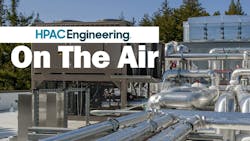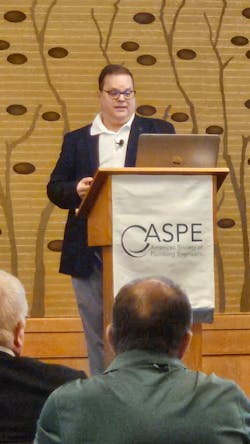HPAC 'On The Air': Refrigerants Deadline Refresher, with ICC's Jim Cika
In this episode, HPAC On The Air welcomes back Jim Cika, director of PMG technical resources for the International Code Council (ICC).
Mr. Cika first joined us here in June 2022 to discuss the major code changes for A2L refrigerants that were then 18 months away. Now, set to take effect in January, those changes are just around the corner, and many in the market are still scrambling to get ready.
- Take HPAC's latest quiz on Refrigerants Regulation, here.
With that in mind, he updates us here on the flurry of related activities still taking place to help our industry prepare.
Click below to listen...
############
- To see ICC's resource page on Preparing for A2L Refrigerants, click here.
- To see AHRI's resource page on Safe Refrigerant Transition, click here.
############
EDITED TRANSCRIPT
HPAC: Our returning guest this month is Jim Cika, director of PMG technical resources for the International Code Council (ICC). With more than 20 years of industry experience in manufacturing and construction, including time as an HVAC design engineer, Jim holds a mechanical engineering degree from Georgia Tech. Now, as deadlines rapidly approach, he updates us on the major code changes for A2L refrigerants that are literally now around the corner. So Jim, thanks so much for returning to HPAC On The Air.
Jim Cika: Thank you. It's great to be back to you today to provide listeners with the update on the EPA phasedown and the transition from the HFC A2L refrigerants.
HPAC: Now we last spoke in the middle of summer 2022 about the upcoming deadlines for the EPA phasedown of HFC refrigerants over the next 15 years. The first major target dates were the end of this year. So please give us an update on what movement and progress you've seen in the market on this issue?
Cika: Sure. So when we first spoke, that was June of last year. Our focus then was on the details and the history behind the HFC phasedown, particularly how it applies to residential and light commercial air conditioners and heat pumps. And then I went into how it impacted building codes and in particular there the International Building, Fire and Mechanical codes. You may recall that with regards to the phasedown, the EPA's phasedown schedule, the HFC production and consumption were limited to 90% of their historic baseline levels beginning in January of 2023.
As expected, those limitations have already impacted the availability and the cost of the HFC refrigerants in the marketplace. So, beginning in January 2024, the total quantity of the allowed HFC production and consumption will drop another 30%, taking them to the 60% level of the historic baseline. And this will be followed again in 2029 with another 30% baseline reduction. And that EPA phasedown schedule is fixed. So, these reduction levels will not be changing. That means we can expect that further market disruptions will occur this coming year and in the years that follow.
Regarding the impacts of the phasedown on the building codes, at the time of our last podcast, ICC had just completed the final stages of its 2024 code development process. So that allowed me then to review all of the approved changes that are forthcoming in the 2024 IBC, IFC and IMC that are related to the A2L refrigerants.
It also gave us the opportunity to discuss the industry efforts needed to prepare for the next stages of the EPA phasedown. Since our last meeting, the 2024 IBC and IMC have been published and released for distribution. So, things have been moving forward.
HPAC: And what about the International Fire Code?
Cika: The 2024 IFC is in its final publication stages, as we speak, and is scheduled to be released in November. The 2024 I-Code changes are aligned with the EPA requirements and support the appliance manufacturers that are already transitioning their equipment to A2L refrigerants.
So, as we discussed, the timing of the EPA regulations and the availability of the 2024 codes posed a bit of a dilemma for the industry. Primarily, how could contractors and local building officials plan for the changes if the codes weren't even published or adopted yet?
Over the last year, the Code Council has been working in collaboration with the Air Conditioning Heating and Refrigeration Institute (AHRI) and some other industry partners to prepare the construction industry for these changes and to help them navigate the changes. The Code Council has developed what we're calling a Hot Topics page on our website that covers the upcoming code changes related to A2L refrigerants and provides other important resources on the topic.
This web page provides access to documents that contain the code language necessary to amend the IMC, IFC and IBC, with A2L provisions that are found in the 2024 I codes. To simplify matters for regulators, documents have also been provided for each version of the code going as far back as 2012. So, whether the local jurisdiction currently adopts the 2012 to 2015, 2018 or 2021 versions of the codes, they'll have access to all of the relevant code provisions they'll need to address the use of the A2L refrigerants.
AHRI has also developed web resources to help with this refrigerant transition and they've created a Safe Refrigerant Transition website that includes many resources, fact sheets, presentations and webinars that provide information about the industry transition to the A2L refrigerants. So, where the ICC Hot Topics page is geared more towards the legislators, building officials, architects and engineers, the AHRI website is geared more towards the HVAC, and our industry, in general. But both sites are valuable resources for anyone researching the A2L refrigerant topic. Now, we're looking at other ways to get the word out on this, too.
HPAC: To that point, with the deadline pretty much upon us, tell us a bit about those other efforts that ICC and other groups are undertaking in these last few months to 'get the word out', as you say.
Cika: Well, as part of our collaboration with AHRI, we've been working with them and other industry partners, which include ACCA, PHCC, and HARDI, to raise awareness about the industry resources that are available on this topic. Right now, we're working on creating a short video series that addresses building officials and HVAC and our contractor concerns and provides answers to questions about the transition to a A2Ls in the coming months.
We'll also be using these videos to get the word out through social media campaigns. Some of the topics that we're going to be covering in these videos are things like how to prepare for the refrigerant transition; what changes were made to the codes and standards, etc. We'll be covering restrictions on refrigerant use, some of the basics of handling A2L refrigerants, and we'll get more into the 2024 and 2025 deadlines for the phasedown. We'll also get into the availability of the training resources and where to find them.
After we shoot these videos, the Code Council and each of our partners will begin sending out social media posts, be it on LinkedIn, Twitter (X), Facebook, and any other platforms. And by each of the organizations focusing and targeting their individual networks, when you add them all up, that creates a pretty big network. And when you add in all the other partners going out to their already established networks, you get a much broader audience.
HPAC: So, how can HPAC readers and listeners get involved?
Cika: If you're not currently following the Code Council or our partners on social media, I would encourage you to do that today. If you are following us on social media, you'll begin seeing our posts on this subject in the coming weeks. So, you'll have the videos to look at, which provide information and offer directions to the websites and other resources for further reference and action.
We'll be doing that periodically in the coming months, and even the coming years, if necessary, depending on how much information is needed as we go through 2024. So once the listeners begin receiving our posts, they can then comment and repost on their own social media networks. Again, expanding that outreach of the campaigns even further.
HPAC: Well, we'll certainly do our part on HPAC's social media sites. So, in the near term, what is the firmest deadline approaching that our audience members should have on the front burners for this transition? Is New Year's Day really the day this all kicks in?
Cika: Yes, January 1st is when the 30% additional limitation on HFC refrigerants takes place. So January 1, 2024, will see a further restriction of the amount of HFC refrigerants in the marketplace. Remember, we already had a 10% reduction hit us in January of this year. And that already impacted pricing and availability, Now, it's going to be restricted another 30%, in addition to that 10%. So, it's definitely going to have some impacts.
HPAC: No doubt. Looking ahead, where do you think we will be a year from now in this whole transition? What would you say is the level of awareness in the market right now?
Cika: Well, let me just take a step back first. Looking at the HFC phasedown and the related code changes for A2Ls, there really hasn't been any revisions or changes in the deadlines that we haven't already discussed. However, EPA just published a new final rule on HFC technology transition. This is a program for the HVACR industry that again, is going to have an impact in the marketplace and is tied to the whole HFC phasedown. This new rule does multiple things.
The first is it prohibits the manufacture and import of some self-contained, packaged HVAC products. That would include window units and portable air conditioners. These are units right out of the factory. They're like plug-ins, and they're ready to operate. So, what they're restricting is the manufacture of any of these products that use a refrigerant with a higher global warming potential (GWP). That begins on January 1, 2025, and it prohibits the sale distribution and export of these types of products three years after that date. Again, these are little packaged units, window units, etc. They won't be able to make those after next year.
The new rule also prohibits the installation of new residential and light commercial air conditioning systems and heat pumps that use higher-GWP HFCs, beginning January 1, 2025.
So there's two differences there: one for the manufacturer and one regarding installation. With the systems, these include air conditioning, heat pump split systems and mini-split systems, things that are assembled and charged in the field. So that's probably what most of our listeners are going to be interested in.
Essentially what the rule is doing is setting the limit for the HFC refrigerants that are used in equipment for any new HVAC system to a global warming potential value of 700. That's the maximum GWP value that you'll be able to see for the refrigerants used after January 1, 2025. This is important because the global warming potential values for many of the HFCs covered by the phasedown have GWPs that are greater than 700.
Basically, those new installs of split systems and heat pumps won't be able to use refrigerants with GWPs above 700. So even though the phasedown goes for 15 years on new systems, you're going to be limited even further to a very small number of usable refrigerants.
HPAC: How does the phasedown deal with existing equipment? Can they be upgraded is replacement the only option?
Cika: Well, what EPA is doing is still allowing the manufacture of the equipment and installation, but it is purely for repairing existing systems. So, if an existing system utilizes a refrigerant with HFCs in the range of say 1,500 to 2,000 GWPs, they cannot be used for a new system. But if someone had a condensing unit that went out, the manufacturers can still produce them as replacement units for repair only.
So the system already has to be in existence and running, and then they'll be able to use that new equipment. They're not making manufacturers stop manufacturing, but they are stopping installers and service contractors from installing them in certain cases. Again, though, the final rule just came out (in October). It was posted on the federal website. So, it's very new and it can be very impactful.
Where do I see us a year from now?
I see this HFC equipment transition program forcing a much faster transition to equipment that uses A2L refrigerants. And I also see this having a significant impact on the service contractors and the service sector. So, for those listeners that are in the HVAC service industry, you may now have to carry parts and components for use in both HFC systems and A2L systems much earlier than you may have otherwise been planning for.
Outside of that, I think we're just going to have to take a 'wait and see' attitude, because again, this new rule just went into effect and, from past experience, I also know there may be some attempt to stop it (in the courts). But even if there are lawsuits, I just don't see this stopping. It's very tough to stop these things once they're in motion. And this one was kind of driven by the manufacturers, anyway. So, I think EPA is really set on proceeding with it.
HPAC: Of course, the Code Council deals with much more than refrigerants. So, other than these pressing issues with the A2L transition, what should our readers also be aware of at the moment?
Cika: For me, looking back over the past several years, and now, with all the changes in the plumbing and the mechanical codes in place, I must say that the COVID pandemic has had an incredible impact on our lives. One thing I've learned working for the Code Council is how much the design and layout of a building can impact the health and safety of the occupants. I've been privileged to serve as a staff liaison to the Code Council's Pandemic Task Force, and this group has been researching the effects of the COVID 19 pandemic on the built environment. It has developed some guidelines and recommended practices, and other publications related to pandemics, and is currently in the process of recommending changes to the I-Codes that are necessary to overcome the numerous challenges we face during pandemics.
These recommended changes will impact several areas of the codes, including building occupant loads, ventilation and filtration systems, water distribution systems for the plumbing code and system control schemes and other areas of the code. The ICC task force is set to submit its recommendations for code changes in the 2024 code development process, which just opened up this past week. This is for the 2027 additions of the codes.
So, much like the code changes that were developed for the handling of A2L refrigerants, I really foresee similar support activities and awareness campaigns will be needed for the changes that are coming in 2027, and beyond that... Our code development is a three-year process, but the mechanical code, building code, fire code, etc., are all in the first year of the cycle. So, really by the end of next year, by the end of 2024, we'll have a good idea of what the new changes are going to be and what impacts they will have for the mechanical contractors and the HVAC industry.
##########
To listen to previous 'HPAC On The Air' podcasts, visit our Members Only page.
About the Author
Rob McManamy
Editor in Chief
An industry reporter and editor since 1987, McManamy joined HPAC Engineering in September 2017, after three years with BuiltWorlds.com, a Chicago-based media startup focused on tech innovation in the built environment. He has been covering design and construction issues for more than 30 years, having started at Engineering News-Record (ENR) in New York, before becoming its Midwest Bureau Chief in 1990. In 1998, McManamy was named Editor-in-Chief of Design-Build magazine, where he served for four years. He subsequently worked as an editor and freelance writer for Building Design + Construction and Public Works magazines.
A native of Bronx, NY, he is a graduate of both the University of Virginia, and The John Marshall Law School in Chicago.
Contact him at [email protected].


